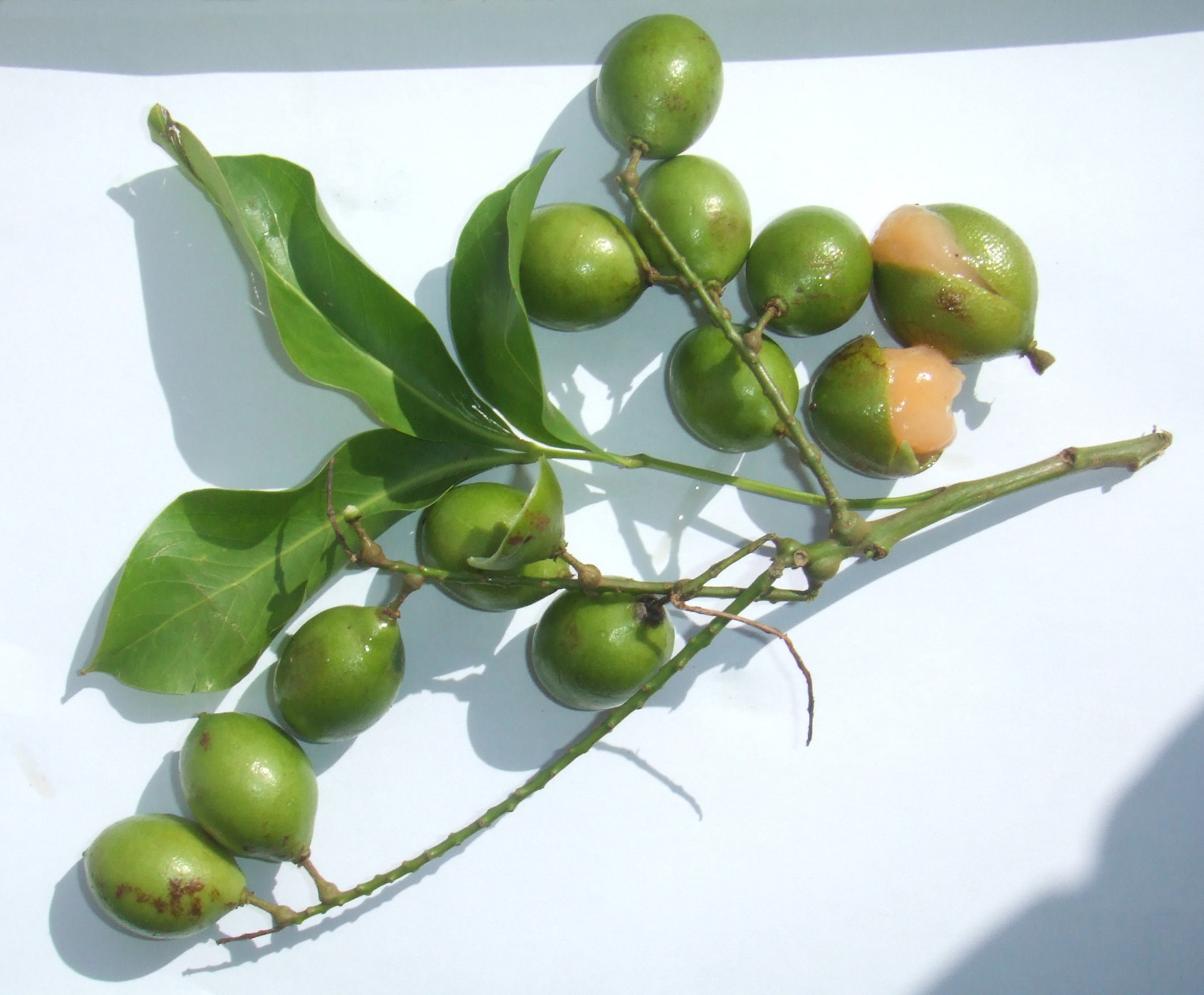- Mamoncillo
taxobox
name = Mamoncillo
image_caption = Mamoncillo leaf and fruit
regnum =Plantae
unranked_divisio =Angiosperms
unranked_classis =Eudicots
unranked_ordo =Rosids
ordo =Sapindales
familia =Sapindaceae
genus = "Melicoccus "
species = "M. bijugatus"
binomial = "Melicoccus bijugatus"
binomial_authority = Jacq.|The mamoncillo ("Melicoccus bijugatus"), also known as the mamón (although the word is considered obscene in some Spanish speaking countries where it translates roughly as ), chenet (in
Trinidad and Tobago ), guaya, gnep, ginep, skinnip (inJamaica , St. Kitts) genip, guinep, ginnip, kenèp (inHaiti ), quenepa (inPuerto Rico ), ackee (inBarbados ), Spanish lime, or limoncillo (inDominican Republic ), is afruit -bearingtree in the soapberry familySapindaceae , native or naturalised over a wide area of the American tropics includingCentral America ,Mexico ,Colombia ,Venezuela ,Dominican Republic ,Guyana ,Suriname and theCaribbean . It is a large tree growing up to 30 m high. The leaves are alternate, 8–5 cm long, pinnate with 4 or 6 opposite leaflets (no terminal leaflet), each leaflet 5–10 cm long.It is grown and cultivated for its ovoid, green fruit, which grow in bunches. The fruit ripen during the summer. The fruit, similar to that of the related
lychee , is classified as adrupe . A mamoncillo fruit has a tight and thin but rigid layer of skin, traditionally cracked by the teeth. Inside the skin is the tart, tangy, cream pulp of the fruit, which is sucked by putting the whole fruit inside the mouth (the seed takes most of the volume of what is inside the skin). Despite the light color of the fruit's flesh, the juice stains a dark brown color, and was often used by indigenousArawak natives to dye cloth.Each mamoncillo fruit has a large
seed inside, the same ovoid shape as the fruit itself. Mamoncillo seeds can be roasted and eaten just likesunflower seeds orchestnut s.The mamoncillo has small, greenish-white, fragrant
flower s inpanicle s. They begin to blossom from the branch tips when the rainy season begins. The mamoncillo is an example of a polygamous plant, producing bisexual flowers as well as flowers that are exclusively male or exclusively female. Occasionally, a bisexual flower will have a "dud" (sterile) anther, which limits the number of fruits produced from self-pollination when cross-pollination is possible.Being tropical, the mamoncillo prefers warmer temperatures. Its leaves can be damaged if the temperature hits freezing point, with serious damage occurring below -4°C. Gardeners of mamoncillos should occasionally give their plants heavy watering during the summer and propagate via seeds; grafting is also used to propagate
cultivar s.The mamoncillo is also commonly planted along roadsides as an ornamental tree.
According to Caribbean folk wisdom (especially in Jamaica), girls learn the art of kissing by eating the sweet flesh of this fruit, also it is said that if a girl finds two seeds then they'll have twins Fact|date=February 2007.
ee also
*
Ackee
*List of culinary fruits
*Longan
*Lychee
*Rambutan
* For the member of thehoneysuckle ("lonicera") family, sometimes called "honeyberry" by nursery catalogs, seeLonicera caerulea .References and external links
* [http://www.hort.purdue.edu/newcrop/morton/mamoncillo.html Fruits of Warm Climates: Mamoncillo]
* [http://www.montosogardens.com/melicoccus_bijugatus.htm Melicoccus bijugatus (Sapindaceae)]
* [http://www.crfg.org/photocon/1999-3d.jpgImage of fruit]
* [http://www.viequesvisitor.com/natural-vieques/quenepa.html Description of Vieques quenepa trees and recipe for an alcoholic drink called bilí]
Wikimedia Foundation. 2010.
